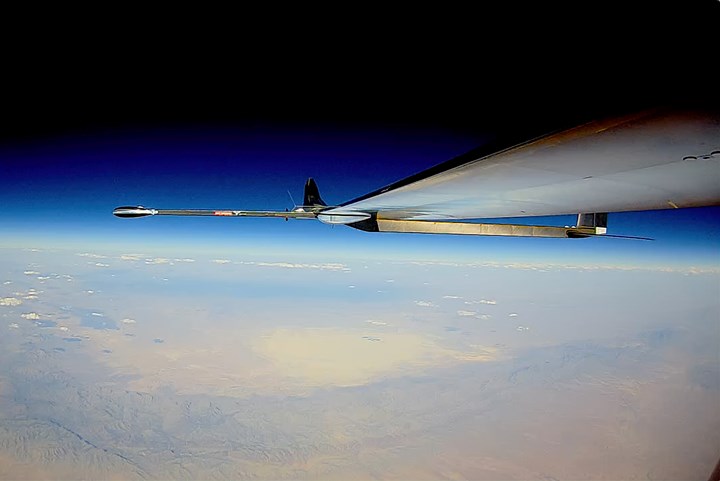PHASA-35 HAPS platform completes first stratospheric flight
First flight of BAE Systems’ uncrewed aerial system demonstrates its potential for long endurance, high altitude and use in future communications applications.
British engineers have successfully completed a stratospheric flight trial of BAE Systems’ (Farnborough, U.K.) high altitude pseudo satellite (HAPS) uncrewed aerial system (UAS), PHASA-35. The trial assessed the performance of the experimental system across a range of areas. It is the first in a series of trials planned to confirm system performance, support development activities and validate test points to enable PHASA-35 to be made available in defense and commercial markets internationally.
Over a 24-hour period, PHASA-35 soared to more than 66,000 feet, reaching the stratosphere, before landing successfully. The trial, completed in June at Spaceport America in New Mexico, flying in the White Sands Missile Range, enabled engineers to assess the performance of the experimental solar-electric drone within the outer reaches of the planet’s atmosphere.
PHASA-35, which has a 35-meter wingspan and carries a 15-kilogram payload, uses a range of technologies including advanced composites.
The flight marks a significant milestone in PHASA-35’s development which began in 2018. Designed by BAE Systems’ subsidiary Prismatic Ltd. (Alton, U.K.) to operate above the weather and conventional air traffic, it has the potential to provide a persistent and stable platform for various uses including ultra-long endurance intelligence, surveillance and reconnaissance, as well as security.
PHASA-35 also has the potential to be used in the delivery of communications networks including 4G and 5G and could be incorporated in a wide range of applications, such as disaster relief and border protection, as an alternative to traditional airborne and satellite systems.
The PHASA-35 program sits within FalconWorks, a new center for advanced and agile research and development (R&D) within BAE Systems’ Air sector, designed to deliver a range of cutting-edge combat air capabilities to the U.K. and its allies.
PHASA-35, which has a 35-meter wingspan and carries a 15-kilogram payload, uses a range of technologies including advanced composites — contracted in 2019, Piran Advanced Composites (Wadebridge, U.K.) produced carbon fiber composites components for the system’s airframe and other flight-critical parts — energy management, solar electric cells and photo-voltaic arrays to provide energy during the day which is stored in rechargeable cells to maintain flight overnight.
The latest trials are sponsored by the U.S. Army Space and Missile Defense Command Technical Center. This test flight at White Sands Missile Range was coordinated and directly supported by personnel attached to Naval Surface Warfare Center, Port Hueneme Division, Detachment White Sands.
“PHASA-35 is breaking new ground — opening up the stratosphere to new possibilities,” Cliff Robson, group managing director for BAE Systems’ Air Sector, says. “This partnership approach is key to our ability to enhance our defense expertise with new thinking and technologies.”
Another composites-intensive HAPS platform, Zephyr, according to Flight Global, is readying itself for a 2024 service launch.
Related Content
-
Carbon fiber in pressure vessels for hydrogen
The emerging H2 economy drives tank development for aircraft, ships and gas transport.
-
The state of recycled carbon fiber
As the need for carbon fiber rises, can recycling fill the gap?
-
One-piece, one-shot, 17-meter wing spar for high-rate aircraft manufacture
GKN Aerospace has spent the last five years developing materials strategies and resin transfer molding (RTM) for an aircraft trailing edge wing spar for the Airbus Wing of Tomorrow program.

















